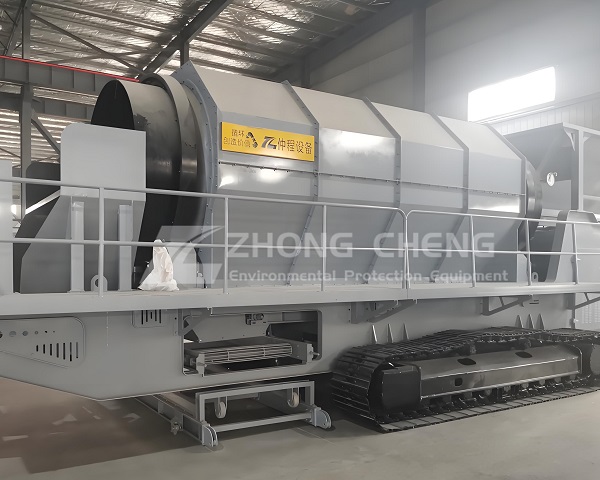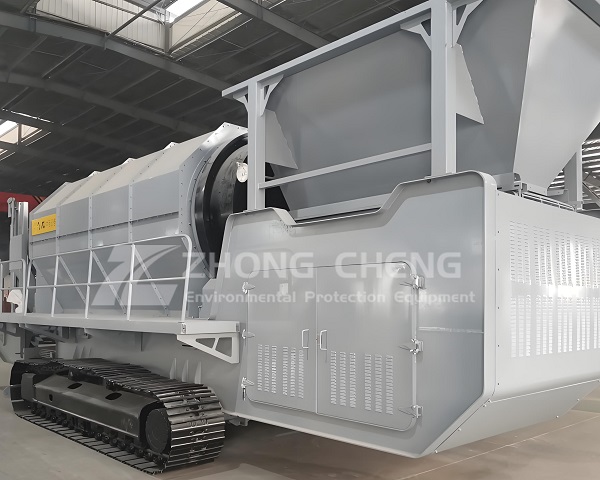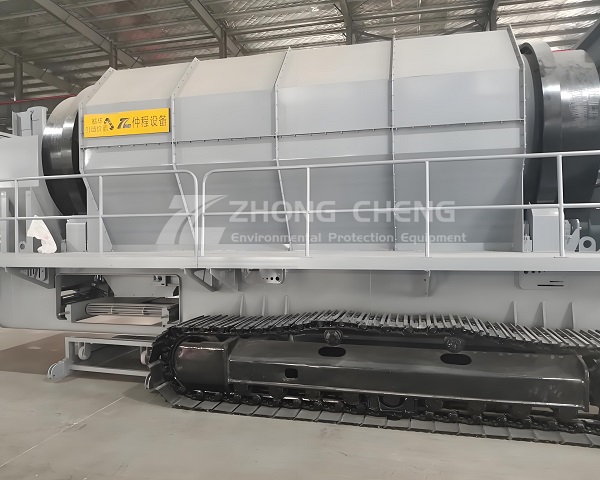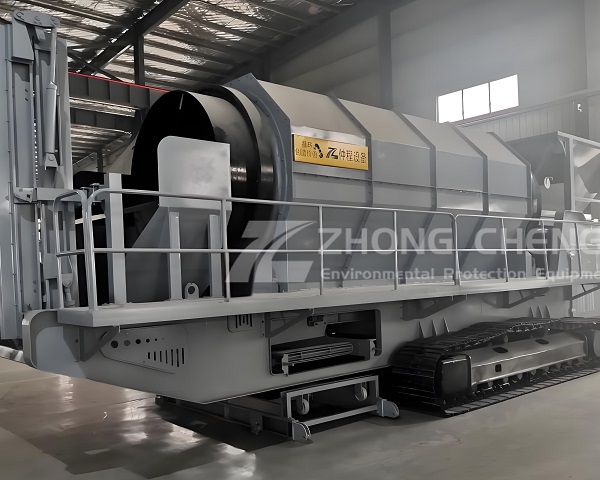As a highly efficient material grading device, the drum screen plays a vital role in material handling processes across various industries due to its unique cylindrical screening structure and stable operating performance. Compared to vibrating screens, drum screens are more suitable for screening large, sticky, and high-moisture materials. Their applications cover multiple fields such as mining, building materials, environmental protection, and agriculture, and they have demonstrated many irreplaceable advantages in long-term use. This article will systematically review the typical application scenarios of drum screens and deeply analyze their core advantages, providing a reference for industry selection and application.
Typical Application Scenarios of Drum Screens

1. Environmental Protection and Solid Waste Treatment Industry
With increasingly stringent environmental protection requirements, drum screens are increasingly widely used in environmental protection fields such as solid waste treatment and wastewater treatment. In municipal solid waste treatment, drum screens are used for pre-treatment grading of waste, separating it into organic matter (such as kitchen waste), inorganic matter (such as plastics and metals), and non-recyclable materials, facilitating subsequent incineration power generation, composting, or landfill disposal, and improving waste treatment efficiency. In sludge treatment, rotary drum screens can separate solid impurities such as sand and metal from the sludge, reducing sludge viscosity and facilitating subsequent dewatering and drying processes, while also protecting treatment equipment from wear. Furthermore, in river dredging projects, rotary drum screens are used to classify the dredged sludge, separating impurities such as stones and branches. The purified sludge can then be used for land improvement or brick making, achieving resource recycling.
2. Mining and Mineral Processing Industry The mining industry is one of the main application areas for rotary drum screens, especially suitable for open-pit coal mines, metal mines, and non-metal mines. In coal mining, rotary drum screens are used for classifying and screening raw coal, separating it into lump coal, medium coal, and fine coal according to particle size to meet the needs of different users (e.g., lump coal for industrial boilers, fine coal for power plants); simultaneously, they can separate impurities such as gangue from the raw coal, improving coal quality. In the processing of metallic ores (such as iron and copper ore), drum screens are used for classifying crushed ore, sending ores of the appropriate particle size to the next stage of flotation or magnetic separation, while large, unqualified pieces are returned to the crusher for re-crushing, forming a closed-loop production process. Furthermore, in the processing of non-metallic ores (such as limestone and quartz sand), drum screens can achieve fine classification of materials, ensuring the uniformity of particle size in subsequent processed products.
3. Building Materials Industry The building materials industry has strict requirements for material particle size, and drum screens are widely used in this field. In the production of sand and gravel aggregates, drum screens are used for classifying natural or manufactured sand, separating sand of different particle sizes (such as coarse sand, medium sand, and fine sand) for use in different scenarios such as concrete mixing and wall construction; at the same time, they can remove impurities such as mud and dust from the sand and gravel, improving aggregate purity. In construction waste recycling, drum screens play a crucial role, grading and separating reusable aggregates, reinforcing steel, and other resources from crushed construction waste (such as concrete blocks and bricks), thus achieving resource recovery of construction waste and complying with environmental protection policies. Furthermore, in cement production, drum screens are used for raw material pretreatment, screening out qualified limestone, clay, and other raw materials to prevent large impurities from affecting the efficiency of subsequent grinding processes.
4. Agriculture and Grain Processing Industry In agricultural production, drum screens are mainly used for screening and purifying grains and seeds. In the processing of grains such as wheat, corn, and rice, drum screens can remove impurities such as straw, dust, and sand, improving grain purity; they can also grade grains by particle size, screening out high-quality grains for further processing and lower-grade grains for feed processing. In seed processing, drum screens are used for seed grading and selection, separating plump and uniform seeds, improving seed germination rates and crop yields. Furthermore, in the processing of traditional Chinese medicine, drum screens can screen raw materials of different sizes, providing standardized raw materials for subsequent slicing and processing steps, ensuring the quality of processed medicinal materials.

5. Chemical and Food Processing Industries
In the chemical industry, drum screens are used for grading and removing impurities from chemical raw materials. For example, in fertilizer production, they are used to screen fertilizer products with uniform particle sizes and remove lumps and impurities generated during production. In plastic granule production, they are used to grade plastic granules of different sizes to meet the injection molding requirements of different products. In the food processing industry, drum screens are used for screening and purifying food raw materials. For example, in flour processing, they are used to remove impurities such as bran; in candy production, they are used to screen uniform sugar granules; and in nut processing, they are used to separate nuts from shells and debris, ensuring food hygiene and quality. Due to the high hygiene requirements of the food industry, drum screens used in these applications are usually made of stainless steel for easy cleaning and disinfection.
Core Advantages of Rotary Drum Screens
High Screening Efficiency and Strong Adaptability: Rotary drum screens utilize a cylindrical rotating structure. Material makes full contact with the screen mesh inside the drum through gravity. Simultaneously, the rotation of the drum causes the material to tumble and slide, preventing material accumulation on the screen surface and significantly improving screening efficiency. Compared to vibrating screens, rotary drum screens are more suitable for materials with high viscosity and moisture content (such as sludge and wet sand) because their rotational motion effectively prevents material from clogging the screen mesh. Vibrating screens are prone to screen clogging when processing such materials, leading to decreased screening efficiency. Furthermore, the screen mesh size of rotary drum screens can be flexibly adjusted according to needs, achieving various grading requirements from coarse screening (tens of millimeters in particle size) to fine screening (several millimeters in particle size), adapting to the material processing needs of different industries.

2. Stable Operation and Long Service Life: The rotary drum screen has a reasonable structural design. The main load-bearing components (such as the drum and support) are made of high-strength steel, offering high strength and good wear resistance, capable of withstanding the impact load of large materials. Its transmission system uses gear or belt drive, ensuring smooth operation, low noise, and a significantly lower failure rate than the high-frequency vibration transmission system of vibrating screens. Meanwhile, the drum screen's mesh is made of wear-resistant steel plate or stainless steel mesh, with a smooth surface, minimizing material wear, and facilitating easy mesh replacement, thus reducing maintenance costs. Under normal maintenance conditions, the drum screen's service life can reach 5-8 years, far exceeding traditional screening equipment, reducing equipment replacement investment for enterprises.
3. Low Energy Consumption and Low Operating Costs The drum screen's operation relies on the synergistic effect of material gravity and drum rotation, eliminating the need for the enormous power consumption of high-frequency vibration. Its motor power is typically only 30%-50% of that of a vibrating screen with the same processing capacity, significantly reducing energy consumption. Furthermore, the drum screen operates smoothly with minimal vibration, requiring less stringent foundation requirements and eliminating the need for complex vibration damping devices, thus reducing equipment installation costs. In terms of maintenance, the drum screen has few vulnerable parts, mainly the screen and bearings, and the maintenance process is simple, requiring no specialized technicians to perform routine maintenance, further reducing the enterprise's operating and maintenance costs.
4. Excellent Screening Effect and High Grading Accuracy: The drum of the rotary drum screen is installed at an inclined angle (usually 3°-8°). The residence time of the material inside the drum can be flexibly controlled by adjusting the drum speed or the inclination angle, ensuring thorough screening. Its screen mesh has a cylindrical structure with uniformly distributed mesh openings. The material passes through the screen multiple times during drum rotation, resulting in high grading accuracy and good uniformity of the undersize product. For example, in sand and gravel aggregate production, the rotary drum screen can grade sand and gravel into multiple grades with a particle size error of no more than ±1mm, meeting high-standard engineering material requirements. Furthermore, the rotary drum screen can be equipped with multiple layers of screens (usually 1-3 layers) to achieve multiple grading with a single feed, simultaneously obtaining products of various particle sizes and improving production efficiency.

5. Simple Operation and Reliable Safety: The operation of the rotary drum screen is simple. The screening effect can be controlled simply by adjusting the drum speed through the control cabinet. No complex parameter settings are required, and operators can be trained quickly. The equipment operates with low vibration and low noise, creating a more environmentally friendly working environment and effectively protecting the physical and mental health of operators. Meanwhile, rotary drum screens boast comprehensive safety protection measures, typically equipped with protective covers, emergency stop buttons, and other devices to prevent material splashing or equipment malfunctions that could lead to safety accidents. Furthermore, some rotary drum screens employ a sealed design, effectively preventing dust leakage and meeting environmental protection requirements, making them particularly suitable for environments with severe dust pollution (such as mining and building materials industries).
Droll drum screens, with their wide range of applications and outstanding core advantages, have become key equipment in material handling processes across multiple industries. Their high-efficiency screening performance, stable operation, low operating costs, and excellent environmental characteristics give them irreplaceable advantages in mining, building materials, environmental solid waste treatment, and agricultural processing. With continuous advancements in industrial technology, rotary drum screens will develop towards larger scale, greater intelligence, and energy efficiency. For example, they will adopt intelligent control systems for automatic speed adjustment and automatic fault alarms, and utilize new wear-resistant materials to extend equipment lifespan, further expanding their application scope and providing strong support for efficient production and green development in various industries. When selecting a rotary drum screen, companies can rationally choose the model, screen mesh size, and installation method based on their material characteristics, processing capacity, and grading requirements to fully leverage its technological advantages and improve production efficiency and product quality.
Save Time! Get A Detailed Quotation Quickly.
